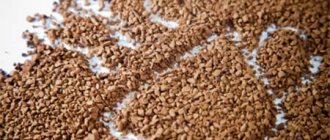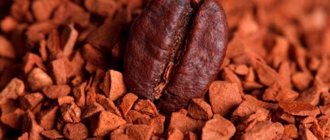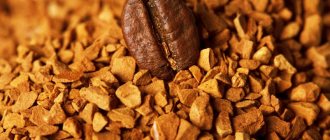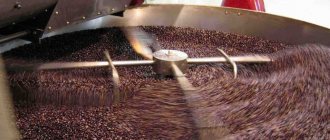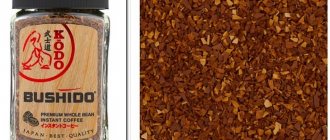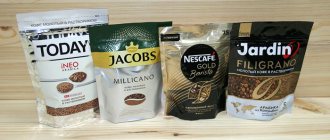Despite the fact that many coffee lovers do not consider instant coffee to be a natural product, it remains very popular all over the world. In Russia alone, at least 40% of buyers choose it. And this love is not accidental. We decided to figure out how instant coffee is created, whether it has any benefits and how, knowing a few simple secrets, you can prepare the most delicious drink. And the answers that we could not find in open sources were given to us by an expert from TEA.ru - an international expert in the field of coffee quality assessment Ilya Goncharov
.
History of instant coffee
Coffee as a natural energy drink is good for everyone, except for one thing: it is too difficult to prepare in the field. Therefore, already in the 18th century, the idea arose of creating a coffee concentrate that did not require long brewing in a Turk. The first instant coffee, called Blend Coffee, was created in 1771 in Britain.
Its taste and aroma were much worse than that of natural coffee, but the War Ministry purchased the “Coffee Blend” for the needs of the army. Until our time, almost all major improvements in the technology for producing instant coffee occurred either at the request of military departments or during wars.
Instant coffee appeared in the USA in 1853. It was not cheap, since the raw material was expensive Arabica, and the taste and smell left much to be desired. The concentrate was not in demand until 1861, when the Civil War broke out in the country. Instant coffee bars, called “cakes,” were included in the rations of Northern soldiers.
In the second half of the 19th century, scientists from different countries worked on the creation of high-quality instant coffee. Variants of the powder manufacturing technology were patented: in 1881 by the Frenchman Alphonse Alleys, in 1890 by the New Zealander David Strang, in 1901 by the American Satori Kato. The concentrate was advertised as coffee for travelers, but people were reluctant to buy it.
George Constant Louis Washington, a Belgian scientist who lived in Guatemala for a long time, developed his own method for producing instant coffee. He moved to the USA and, despite the fact that many experts spoke negatively about the taste of the drink, he founded the company in 1909 and began producing Red E Coffee.
Instant coffee and world wars
If in peacetime consumers preferred more aromatic and refined natural coffee, then for soldiers the most important thing was the simplicity and speed of preparing the drink. The popularity of the concentrate was also facilitated by the fact that, starting in 1913, the US government banned the use of alcohol in the navy.
When the country entered World War I in 1917, instant coffee became a real salvation for soldiers. People who were accustomed to morning coffee were plagued by headaches due to a lack of caffeine. But it was simply impossible to brew natural coffee in the field kitchens, since the aromatic steam gave away the location of the positions to the enemy, and the Germans could use the poisonous mustard gas at any time. The American military had to strengthen their strength with a concentrate dissolved in hot water.
In honor of the most famous manufacturer of instant coffee, soldiers' tin mugs began to be called “Joe mugs”, and the creator himself was called “the soldier’s friend.” By the fall of 1918, the U.S. War Department was ordering 37,000 pounds (14.8 tons) of instant coffee daily, although as recently as 1916 all U.S. companies were producing only 6,000 pounds (2.4 tons) of concentrate per day.
When the war ended, Washington's company flooded the United States with leaflets featuring a military-clad coffee can. The inscription read: “Went to war. Home again." The soldiers, accustomed to instant coffee, returned home and accustomed their families to it.
Instant coffee returned from the war with the soldiers
Until 1938, George Washington's company dominated the international instant coffee market. But in the 30s of the 20th century, a crisis of overproduction broke out in Brazil: huge reserves of robusta could not be sold, and coffee prices collapsed.
The Brazilian government turned to the management of the Swiss company Nestle with a request to help process the robusta that had accumulated in warehouses. Scientist Max Morgenthaler created a technology for evaporating coffee extract with hot air, which made it possible to obtain coffee of much better quality than other samples on the market. Since that time, the profits of the George Washington company began to decrease, in 1943 it was sold, and in 1961 it stopped producing instant coffee.
In Nestle coffee, instant coffee was called Nescafе, carbohydrates were added to the composition for better solubility than the Red E Coffee familiar to Americans. In Switzerland, the first sales of Nescafé took place on April 1, 1938. The concentrate was such a success that the company began building a plant in London. But the main customer of the new drink was the US War Department. During World War II, it purchased about a million cases of Nescafe.
Creator of Nescafe instant coffee, chemist Max Morgenthaler at work
Although the supplier of the concentrate was different, the US military still called both instant coffee and natural coffee prepared in a filter coffee maker “Mug of Joe.” By demanding that this coffee be prepared for them, the American soldiers drove the Italian baristas into hysterics until they realized to dilute the strong espresso with water. This is how the Americano coffee recipe came about.
Discovery of the sublimation process
Scientists at the National Research Corporation (NRC), located in Massachusetts, commissioned by the military department during World War II, worked on the development of high-vacuum technologies (for producing penicillin, streptomycin, and blood plasma). It turns out that the same principle applies to instant coffee. Moreover, the concentrate frozen in a vacuum turned out to be an order of magnitude better than that dried with hot air.
The composition of instant coffee has also improved: starting in 1954, Nescafe, and then the products of other brands, stopped stabilizing them with carbohydrates. By the 1980s, up to 40% of instant coffee from well-known brands was produced using the sublimation method.
In the 21st century, the time has come for new technologies. The legendary Don Valencia, who headed the scientific research department of Starbuks, created freeze-dried coffee that tastes as close as possible to natural coffee. Now this coffee, called Via, is added to all Pepsi coffee drinks.
Recipe with ginger
This recipe will warm you up on a chilly day, boost your immunity, and protect you from ARVI. For one cup, take one teaspoon of grated ginger root and pour boiling water over it for 5-8 minutes. The finished infusion is filtered. Coffee powder is poured into an empty cup and filled with ginger infusion. You can add honey as a sweetener, or a slice of lemon would be appropriate.
Citrus fruits (lemon, orange, grapefruit) perfectly complement the taste of the coffee drink. When adding a small amount of natural juice, the bitterness softens and a piquant citrus shade appears.
Instant coffee makes wonderful drinks. Knowing the subtleties and secrets of preparation, a true craftsman will create a coffee masterpiece, the taste of which makes it difficult to determine which product was used as a base - natural or instant. Don’t hide your know-how, feel like a coffee master and share the secrets of your craft!
Technologies for the production of instant coffee
Today, about 50% of green coffee beans are processed into instant coffee. To make it, manufacturers buy the cheapest beans: robusta and low-grade Arabica.
Based on its composition, instant coffee is divided into:
- made from 100% robusta;
- made from a mixture of Arabica and Robusta;
- containing 100% Arabica.
The beans are medium roasted (mostly American). Roasted beans should not be ground immediately, otherwise they will begin to explode. Within 3–4 hours after roasting, the coffee “rests,” releasing aromatic substances and volatile products formed when organic matter is heated. Then the grains are ground. The grains must be at least 0.5–1.1 mm in diameter, otherwise due to the high temperature they will begin to burn, giving the concentrate a burnt cork smell.
A stream of water at a temperature of +140 to +180 °C is applied to the ground grains placed in columns under high pressure. As a result, carbohydrates are washed out of coffee. When the water cools to +100 °C, aromatic substances dissolve in it. The process takes several hours. The liquid is then cooled to +40 °C. At the end of the cycle, a coffee extract containing 20–30% solids is obtained.
It is filtered and thickened using one of three methods:
- separate the water using a centrifuge;
- evaporate;
- frozen and mechanically separated the frozen water crystals from the coffee extract crystals.
The resulting thick coffee extract contains up to 40% solids, but is almost completely devoid of volatile aromatic compounds. To later impart aroma to instant coffee, manufacturers collect essential oils. This is one of the most difficult processes, since the slightest violation of technology leads to the fact that the powder acquires a musty smell.
Each manufacturer has its own secrets. Some collect aromatic substances that evaporate after roasting. Others moisten the ground coffee and heat it under reduced pressure, which releases the aromatic components. Sometimes warm nitrogen is passed through a layer of moistened ground coffee and the gas is vented into a cryochamber where the aromatic compounds are separated.
There are 2 technologies for producing instant coffee:
- spray dry - hot drying. The extract is sprayed under a stream of hot air. As a result, the moisture evaporates and powdered instant coffee is formed. If you need to make it granular, the powder is additionally treated with steam;
- freeze-dried – freeze-drying (a method for producing freeze-dried coffee). The coffee extract is pre-cooled to a temperature of –6 °C. Then it is applied in a thin layer to a drum, steel belt or pallet and frozen to a temperature of – 40 °C. If freezing occurs quickly, within 0.5–4 minutes, small light crystals are obtained. Slow freezing (10–180 minutes) produces large dark granules. Ice slabs are broken, ground and sifted. Small particles are sent for re-freezing. Large pieces of ice are placed in a vacuum chamber, where the water instantly expands. It is removed using convection.
At the last stage, instant coffee is flavored. Natural essential oils extracted from grains are added to expensive varieties, while artificial flavors are added to cheap varieties.
Instant coffee without caffeine is available on sale. It is obtained by passing green coffee bean extract through a carbon filter, which retains caffeine molecules. The cost (and therefore the price) of such coffee is more expensive than regular coffee.
Recipes
The classic recipe for making instant coffee involves using 1 teaspoon per 60 - 70 ml of water, as for regular lungo. If you use spices, they are mixed with powder, sugar, and then poured with hot water at a temperature of about 80 degrees. The drink should steep for 3 minutes.
With milk
Cow's milk whips better because it has higher fat content. To obtain a fluffy froth, the milk is heated and frothed using a hand frother or a steam wand on a coffee machine. Before this, brew the granules with not very hot water.
Video: Find out the secret of how to brew instant coffee deliciously and correctly
How to choose instant coffee
In order not to make a mistake in choosing instant coffee, you should adhere to the following rules:
- in the store you need to meticulously examine the label: the name and design must be clear, the barcode must correspond to the country of origin;
the best instant coffee is freeze-dried, although powdered and granulated coffee can also have a pleasant taste;
- Arabica coffee tastes better than robusta coffee, but Arabica coffee has less caffeine;
- If you can smell bread notes in the coffee aroma, it means roasted barley has been added to the concentrate. It’s better not to buy this kind of coffee;
- the smell of burnt cork means that the manufacturer overcooked the beans or violated the technology when making the extract. Unfortunately, this and the previous flaw can only be discovered after purchase. But it makes sense to remember the manufacturer and not buy its products again;
- a good concentrate should be completely dissolved in water or milk.
Types and varieties
All available types of instant coffee can be divided into 3 large groups depending on the technology that was used in their production. It's coffee:
- powder (the method of its production is dry spraying);
- granulated (ready powdered coffee is moistened with steam and turned into granules);
- sublimated (manufactured using a low-temperature method; we have a separate material about it).
There is also a classification of soluble product based on the types of raw materials used:
- instant Arabica coffee;
- from a mixture of Arabica and Robusta;
- from robusta.
The first option is the most expensive, the last is the cheapest.
You can find out the difference between a coffee maker and a coffee machine in this material.
Find out how to cook cocoa powder from milk here.
How to brew instant coffee
Its taste largely depends on the technology for preparing instant coffee. The concentrate is never poured with water heated above +90 °C. At higher temperatures, chemical flavors and other additives begin to decompose and give the coffee an unpleasant taste.
Instructions
- Warm a cup with boiling water.
- Pour instant coffee and sugar into the bottom and stir.
- Splash some hot water.
- Mix the contents of the cup thoroughly until the coffee and sugar are completely dissolved.
- Add the rest of the water.
When contacting some types of instant coffee, milk curdles. To avoid this, the concentrate is always first dissolved in a small amount of water and then milk or cream is added.
To give the drink a pleasant taste, before adding water, the concentrate can be mixed with a pinch of cinnamon, cocoa, cardamom, or anise. Latte, ice, cappuccino and other milk-coffee cocktails are prepared from instant coffee.
Instant and ground coffee: what is the difference and which is healthier?
The main difference between these two products is that ground coffee is made from higher quality raw materials - fruits collected at the stage of full ripeness, with rich taste and aroma, containing valuable essential oils and microelements beneficial to the body, such as, for example, like potassium and magnesium, which support heart function.
An instant drink, unfortunately, cannot have such advantages, since its production uses unripe beans, various coffee waste, additives that reduce the cost of the final product, including artificial ones, which means they are not beneficial for humans or even harmful (chemical preservatives can lead, for example, to gastritis).
Even such a “safe” product as decaffeinated instant coffee can pose a health threat: to make it so, manufacturers use solvents and acids, traces of which, although in small quantities, may remain in the final product.
Due to the growing popularity of instant drinks, scientists are increasingly engaged in their research and have found, in particular, that some of the effects of instant and ground coffee on the body may differ. If, for example, you drink instant coffee while eating, then the absorption of iron in the intestines will occur 2-3 times slower than what happens if a person drinks coffee made from ground beans.
However, instant coffee also has advantages over ground coffee, such as a longer shelf life, as well as the ability to quickly prepare the drink in any conditions, even camping conditions.
If a person has some extra time, it is better for him to choose not even ground, but grain coffee - in this case, the likelihood that there will be some foreign ingredients in the cup is completely excluded.
The benefits and harms of instant coffee
Instant coffee contains caffeine, so it affects the body in much the same way as natural coffee: it invigorates, promotes concentration, and has a diuretic effect. It is difficult to judge which coffee has more caffeine: its content in the soluble concentrate depends on the manufacturer. One 250 ml cup of instant coffee can contain from 30 to 200 mg of caffeine.
The alarming thing is that with prolonged heating, the carcinogen acrylamide is formed in the concentrate (this compound is also found in chips and some other products). Scientists say that excessive consumption of instant coffee leads to the formation of kidney stones.
Although experts argue about the benefits and harms of instant coffee, it is not recommended to drink it if you have diseases of the liver, gallbladder and pancreas. The drink contributes to dehydration of the body, which causes premature aging and darkening of the facial skin. Therefore, you should not drink more than 1-2 cups of instant coffee per day.
Coffee bean
The coffee bean is extracted from the red berry, the fruit of the coffee tree. It is precisely this that is the raw material for the production of the product from which several billion people prepare an aromatic drink every morning. If we talk about what coffee is made from - ground, instant, then the basis is always grain.
It can be of different varieties, sizes, degrees of maturity, and so on. Selling beans is serious business, the backbone of the economies of countries like Brazil and Colombia. Before reaching the final consumer's cup, coffee travels a lot and undergoes several technological stages of processing.
The most common variety from which most coffee products are made is Arabica Santos from Brazil.
Its largest copies are used to produce the highest quality grain product, and the rest are used for blending and creating mixtures. Brazil, as the main supplier of coffee to the world market, sells it in unprocessed form.
This is a green dried grain that is stored for a long time and has no odor or taste. Only during the roasting process does it begin to emit a familiar fragrance that invigorates you in the morning and brings you back to life in the middle of the working day.
Arabica and Robusta are two industrial varieties.
In addition to the grain itself, unscrupulous manufacturers can sell mixtures of grain, coffee bean husks, chicory, cereals under the brand name of a natural product, enrich them with flavors, enhancers, and so on.
To be sure of what you drink, you need to purchase green or already roasted coffee beans, grind them yourself and prepare a flavorful drink. If you have a coffee maker at home, or better yet a coffee machine, for example, a Delonghi, the process of preparing a drink is greatly simplified and lasts from 30 seconds to several minutes. You can prepare a variety of drinks in a coffee machine, from standard espresso to iced glass, cappuccino, raf, and so on.

